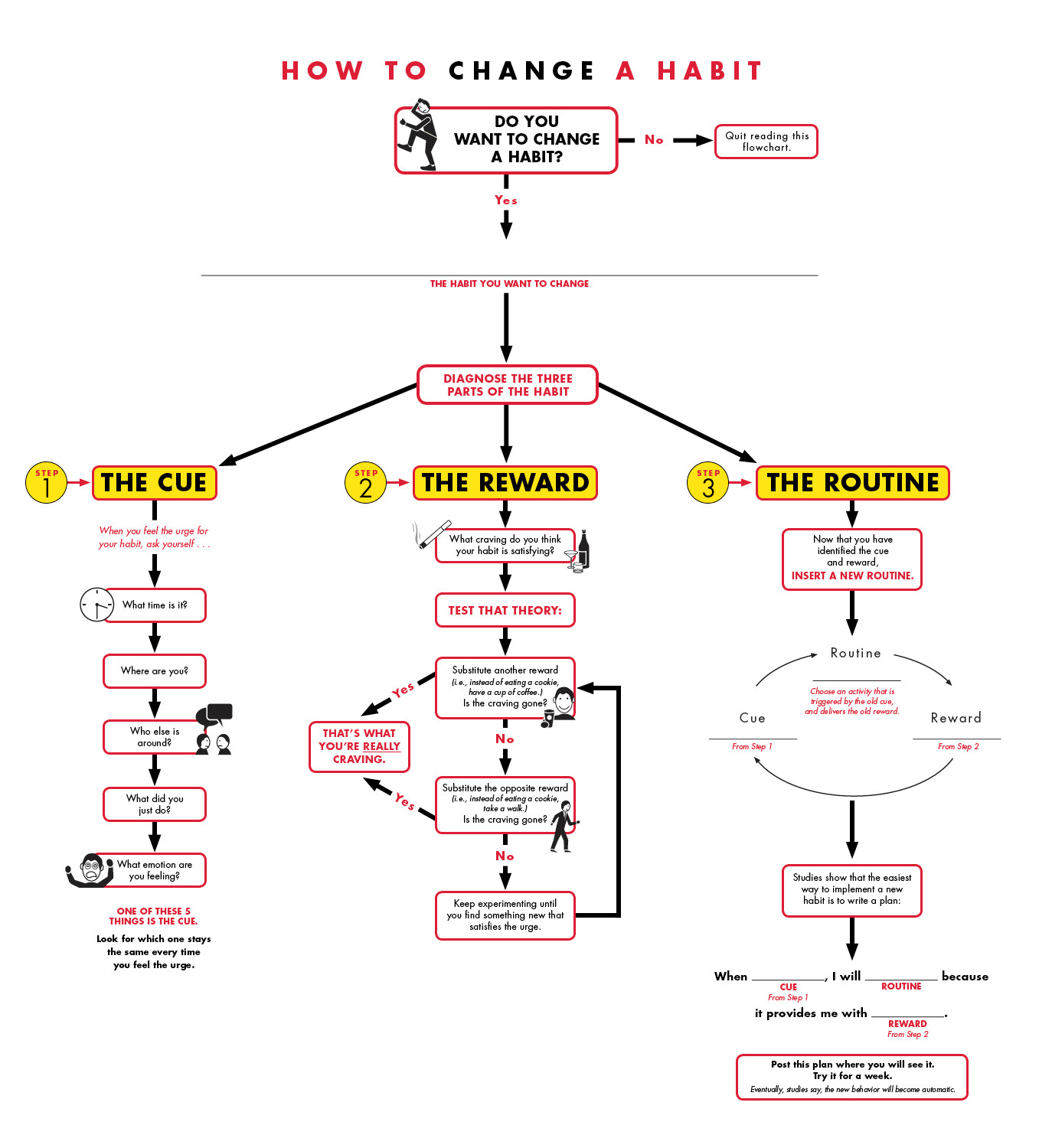Not all habits are created equal. Some will have a much bigger effect on your life. These "high return" habits are often called keystone habits, and if you're going to adopt only one new habit, it should be one of these.
Writer Mark Manson describes keystone habits as "compounding habits":
If you think about building habits as a process of investing in yourself [...] you could say that different habits have higher or lower interest rates, therefore making some habits far better initial investments of your energy and discipline than others.
Keystone habits seem like any other habit, on the surface at least. The difference is that keystone habits tend to have ripple effects which change your behavior in unexpected ways.
Let's dive into what makes keystone habits so powerful and how you can get started building one.
What Are Keystone Habits?

A habit of checking email first thing in the morning may or may not be beneficial to you, but it doesn't really affect other areas of your life, such as your well-being or personal relationships. Similarly, a habit of turning into Netflix every night at 8pm probably doesn't have far-reaching beneficial effects.
Just what makes a habit a keystone habit, then? Charles Duhigg, author of The Power of Habit, explains that keystone habits change more than just our behavior—they change how we see ourselves:
When researchers look at how people change their habitual behaviors, they find when some changes occur, it seems to set off a chain reaction that causes other patterns to change as well.
The power of a keystone habit draws from its ability to change your self image.
Exercising regularly is a habit many of us want to build to get stronger, look better, and stay healthy. For many, people this is a keystone habit, because when they exercise regularly, they also make healthier eating choices, procrastinate less, wash their dishes earlier, and even use their credit cards less! Exercising regularly seems to be an ordinary habit, just like flossing daily or hitting inbox zero before leaving work for the day. It's the cascading effect it has on other areas of your life that makes exercise a keystone habit.
When you build a habit of exercising every day, apart from improving your health and fitness, you're also creating a new self image—one of a person who exercises regularly or, perhaps even more broadly, of a healthy person.
By starting with action that encourages the self-image we want to have, we subconsciously encourage ourselves to reinforce that new self-image with other behaviors.
Examples of Keystone Habits

But when it comes to identifying your own keystone habits, that's where things get tricky. Exercise is the main example used by most people who talk about keystone habits, but according to Duhigg, "anything can become a keystone habit if it has this power to make you see yourself in a different way."
Duhigg mentions some other examples in his book. For instance, children from families who eat dinner together regularly tend to have higher grades, more confidence, and better emotional control. Another interesting example is making your bed every day. This simple, quick keystone habit has been shown to correlate with "better productivity, a greater sense of well-being, and stronger skills at sticking with a budget." Science writer Judy Dutton suggests this might be because "an organized environment can positively impact our mental state," and making our beds in the morning helps us start the day with a sense of accomplishment.
Manson came up with a list of his own six suggestions for keystone habits, including meditation, reading, writing, socialising, and exercising. Manson says his list of habits "provide a nice foundation for a healthy life in all domains: physically, emotionally, psychologically and socially."
He also includes cooking, which might not seem an obvious choice at first. But Manson points out that building a habit of cooking for yourself gives you control over what you eat and when. Without the time or knowledge for cooking, we settle for eating quick, easy food which tends to be unhealthy.
And while cooking itself doesn't necessarily affect your health, eating well definitely does. Building a habit of cooking makes it achievable to eat well.
How to Identify Your Keystone Habits
While I don't cook enough to see a huge difference in my eating habits, I do exercise regularly, something I can confirm is definitely a keystone habit for me. Pinpointing how exercise affects me has helped me figure out the clues that point to a keystone habit, so I can identify others.
At first I wasn't exercising every day, but I noticed patterns that correlated to the days I did exercise, and the days I didn't.
The biggest difference was my mood. I felt good after doing a workout, as if I'd accomplished something important. I felt like I'd started my day off well, and I felt good about facing everything else I needed to do that day.
I also noticed it was easier to eat a healthy breakfast after I'd exercised. Planning a healthy breakfast ahead of time didn’t stop me grabbing something more convenient and less healthy on days I didn’t workout. But the workout made me _want _the healthy breakfast I’d planned.
The great thing about these effects is that I didn't have to try hard to be in a good mood, or to improve my breakfast choices. They just happened. I'd found a cascading effect on my behavior that seemed to correlate with the days I started with a workout.
When I realized what made it obvious that exercise was a keystone habit, I was able to look for clues of other keystone habits in my life. The other major one I've found so far is getting up early. Getting up early sets me up for a great day. My mood tends to be better, and I usually get more done during the day, even if I don't start work any earlier than normal.
All of these effects combine to make a much better day for me. And they all seem to relate to simply getting up earlier, which makes it a keystone habit for me.
While exercising, cooking, or getting up early might not be your keystone habits, these examples point to the clues that can help you find your own:
Look for behaviors that have a ripple effect, changing your other behaviors without extra effort. And pay attention to how you see yourself when you do a particular habit. Does it change your self image? Do you feel better when you think of yourself as a person who flosses, a note-taker during meetings, a runner, or a person who meditates?
Changing our self image is the key to building habits that create major life changes for us.
How to Make Your Keystone Habit Stick
The trick to making any habit stick long-term—keystone or not—is ensuring you do it regularly. The more often you do the habit, the more you'll get used to it, and eventually you'll do it without thinking—the definition of a habit.
Keep track of your habit every day
If you’re working on building new habits, it helps to know how often you’re succeeding (or not). There’s a plethora of habit tracking apps available to keep stats on your efforts. A couple of my favorites are Momentum and HabitBull.
But you can do the same thing with just pen and paper, too. A simple way to keep track of your progress is to mark each day you complete your habit on a calendar. The "don't break the chain" method (often wrongly attributed to Jerry Seinfeld) uses a wall calendar and a marker to create a chain of completed days. The longer your chain of successful days, the less likely you are to break it.
An even simpler approach is theXeffect which uses index cards to track habits. On the back of the card, you write down why you want to build a particular habit. On the front, you simply draw six vertical and six horizontal lines to create a grid of 49 squares. Each squares represents a day, without needing to date them or use a calendar. Like the Seinfeld method, you cross off a square each time you complete the habit. When the card is full, you should have a fairly solid habit, at which point you can decide whether you need to repeat the process or not.
Start small
The idea of starting small is common among successful habit builders. Behavioral scientist BJ Fogg calls this "Minimum Viable Effort," and suggests starting here with all new habits. The key, he says, is to do the minimum you can and be consistent in your behavior.
Make it tiny. To create a new habit, you must first simplify the behavior. Make it tiny, even ridiculous. A good tiny behavior is easy to do — and fast.
For example, walking to work or doing squats for five minutes during your lunch break is a better start than trying to run 5 miles every weekday. Once you've built consistency in doing that tiny behavior every day, it's a lot easier to scale up how much you're doing.
Creating consistency is the hardest part, so start there. You could even use a repeating task in your to-do list app—or an automation from a tool like Zapier—to nudge you to work on your habit consistently.
Plan ahead
Another common suggestion is to make a plan for how and when you'll complete your habit. Coach.me co-founder Tony Stubblebine says planning ahead is the trick to not getting thrown off by unfamiliar situations. When building a habit of not eating sugar, Stubblebine suggested the concession stand at the cinema is one of the many environments where not having a plan could throw off your new habit:
When you go to the movies, what do you order? Popcorn or those ice cream dots? You might be on a three-month streak of no sugar and think you've nailed it, then walk up to concession stand and your old movie theater habit of ordering Red Vines takes over.
Because there are so many variable that can affect our ability to stick with new behaviors, Stubblebine says planning ahead is the best way to build up the consistency we need for the habit to stick:
Now is the time for me to decide if I'm going to have birthday cake, not on April 30 when someone passes me a slice of cake. Because I'm not going to be making a good decision then in that moment.
For me, planning when and where I'll complete a new behavior is the difference between building consistency early on and struggling to make progress at all. If I don't plan a time and place to complete my new habit each day, it tends to not get done. But finding time in my day to schedule that habit ensures I won't be struggling against deadlines or a busy schedule to do it—it already has a place and time set aside for it.
According to The Power of Habit author Charles Duhigg, habits are comprised of three parts: the cue (what triggers the behavior), the reward (what you get out of doing the behavior), and the routine (the behavior itself). Planning ahead helps you keep the reward front-and-center, giving you the strength to overpower old cues with the new ones you're working to build for your habit.

Make It Easy
For my keystone habit of exercise, I've scheduled time to do it and I've started small—I usually do just a 15-minute workout in my living room at around 7am each day. But there are still some days when it seems easier to get on with my workday instead of rolling out my exercise mat and throwing on my workout gear.
I've found that the easier I make it to get started with a new behavior, the fewer reasons I have to not do it. When I make sure my workout clothes are washed, dry, and left out ready for me to put them on, it's harder to find an excuse not to do so. If I download my workout on my phone the night before, there's no waiting around for it the next morning—another excuse gone. And waking up half an hour earlier has helped me schedule my workout earlier so it doesn't interfere with my workday—yet another excuse I can't use anymore.
Sometimes I still struggle to get going in the morning. But if I have a longer, 30-minute workout scheduled and I find I'm thinking about skipping exercise altogether because 30 minutes seems too long, I'll just swap it out for a 15-minute workout.
Think about ways you can make your workout—or other keystone habit—easier to do, something Malcolm Gladwell calls the "tipping point." That's the point at which you overcome resistance and engage in the new behavior.
In a study of college students, fear-based education about tetanus failed to increase the number of students getting tetanus vaccinations. The tipping point came when the education included a map of the campus showing where the health center was. With that extra information, students no longer had the excuse that they didn't know where to get their shot, and couldn't be bothered looking up that information. Everything they needed was in front of them, so it suddenly became a lot easier to get a vaccination.
When you find yourself making excuses about why you're not sticking with your new keystone habit, try to find ways to overcome those excuses. Put out any equipment you need before you need it. Set up your environment so it's ready for whatever habit you're trying to build. Get your family or colleagues on board, so they don't block you.
Look for any small way you can overcome resistance in advance, so you don't have any excuses when it comes time to do your new behavior.
Building habits is a long, slow process. It requires some determination in the beginning, as you work on building momentum and making a new behavior habitual, so you don't have to think about it.
But the rewards are overwhelming. Once you've built a strong habit you'll be performing a healthy behavior without even trying. And if you focus on finding and building keystone habits, you'll be getting a ripple effect of better behaviors throughout your life, just from putting effort into that one new habit.
Learn More About Building Productive Habits
It's easy to start working on a new habit, but far harder keep at it for the long haul. Here's how to build habits that stick, with tips to make your new habit a success.
Need instead to get rid of your worst habits? Here are tricks and apps to help you break your bad habits at work and in your personal life.
Sometimes you have to trick yourself into working on better habits. Here's how to gamify your productivity—and apps that will reward you for working on your new habits.
Title photo by Kurt:S via Flickr. Walking photo by Emma Simpson





